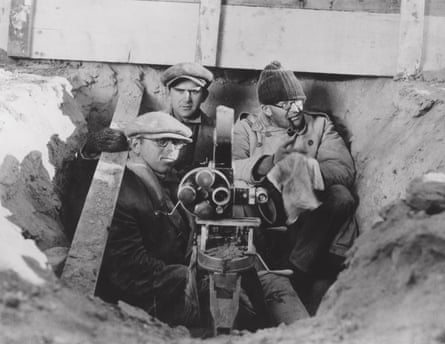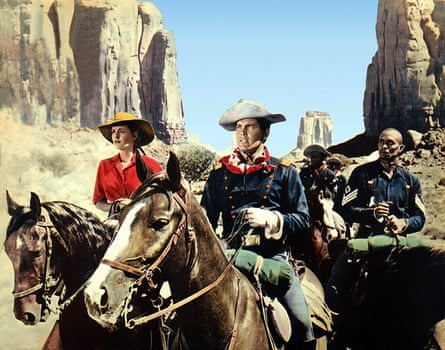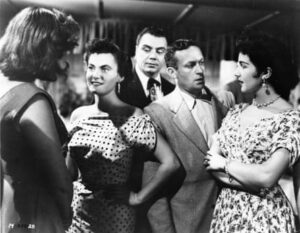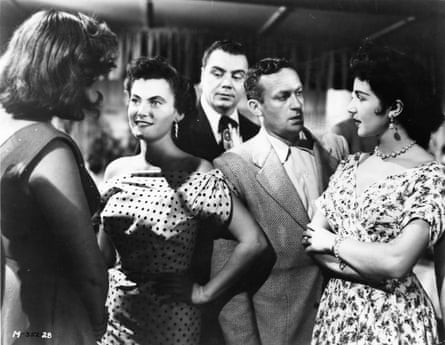Had the Oscars been around in 1924, when director John Ford’s epic western The Iron Horse was released, the critically lauded film would have swept up the lot. Though it might be largely forgotten now, this black and white silent movie, which turns 100 on 28 August, marked the point where Jack Ford – a former fly-by-the-seat-of-his-pants props guy who also acted a bit, and was first hired as a director by virtue of being available – became master film-maker John Ford, the director many still herald as the greatest of all time. When The Iron Horse was inducted into the Library of Congress film archive in 2011, the official registry citation stated that it “established Ford’s reputation as one of Hollywood’s most accomplished directors”.
Ford remains the most Oscar-decorated director ever, notching up four awards for feature films – The Informer (1935), The Grapes of Wrath (1940), How Green Was My Valley (1941), and The Quiet Man (1952) – and two for second world war documentaries The Battle of Midway (1942) and December 7th (1943). None of which were westerns, a genre Ford adored, shaped, and left his mark all over. Incongruous perhaps, given his coastal Maine upbringing by Irish immigrant parents. As a teenager, Jack Feeney followed his elder brother – star actor and director Francis Ford – to Hollywood, taking his surname and learning on the trailblazer’s sets at Universal Pictures. Short on directors, Universal head Carl Laemmle hired him to direct cowboy star Harry Carey in Straight Shooting in 1917, simply because “Jack Ford yells good”.
Three years after Ford moved to Fox Film in 1920, producer William Fox tasked Ford to make a western to rival Paramount Pictures’ 1923 box office hit The Covered Wagon. The Iron Horse was Ford’s response: two and a half hours of history, drama and pictorial beauty – which went way over budget. “It was mostly shot in Nevada,” says Ford biographer Joseph McBride. “It was freezing cold, harsh conditions. But Ford liked to be on location away from the studios.” Reputedly, Fox sent someone to the location to rein Ford in on budget. Ford read the message, held it up and invited a sharpshooter to fire. “He shot a hole through it and Ford sent it back to Fox as an answer,” says McBride.
Overall, though, Fox was not disappointed. Critical success was one thing, but The Iron Horse’s big box office takings elevated Ford’s status within the industry.
“I always say The Iron Horse was for Ford like Jaws was for Steven Spielberg,” says McBride. “It gave him a lot of clout and finally, at the age of 30, he was an A-lister.”

The Iron Horse’s storyline tracks the construction of the US’s first transcontinental railroad, comprising the Union Pacific (west from Omaha, Nebraska) and Central Pacific (initially east from Sacramento, California). Mostly shot in Nevada, Ford’s film traces the railway’s arduous hand-hewn progress in a dry, documentarian style – the opening titles begin: “Accurate and faithful in every particular of fact …” But Charles Kenyon and John Russell’s script is also infused with high drama: good guys, bad guys, and an idealistic hero and heroine who are also star-crossed lovers. The film’s finale shows the last spike, one made of gold, hammered in at Promontory Point, Utah in 1869, as well as the lovers’ happy-ever-after embrace.
George O’Brien, a handsome, sporty ex-Marine, stars as dashing Pony Express rider Davy Brandon. The young Brandon and his father explore the Sierras to find a pass to ease the creation of a railroad. Triumphantly, they find one (Ford used the dramatic Beale’s Cut in Santa Clarita, 26 miles north of Hollywood – a location he returned to for later films). They are ambushed by a band of Cheyenne and Brandon witnesses his father’s vicious murder by Deroux, a two-fingered white man dressed as a Cheyenne. Years later, after construction begins, Brandon offers to search for the pass lost in his childhood memories, and finds his childhood sweetheart Miriam (Madge Bellamy) engaged to the UP’s crooked chief engineer (Cyril Chadwick), who plots with Deroux against the railroad.
Among the 5,000 extras used, Ford does not sideline Native Americans as the bad guys. He shows Deroux manipulating the Cheyenne to attack. In one such scene, spectacularly captured by cinematographer George Schneiderman, a chief is fatally shot and falls to the ground, and a dog appears (from nowhere!) lovingly licking at his face before lying by his body, mourning his death. Is Ford humanising the attacking “Indians”? Sure looks like it. On the other hand, when Irish labourer MacKay gets an arrow in his back, the grief of his companions is highly palpable, a brotherly bond poignantly presented. Violence is an equal opportunities offender.
Ford would later work with the Diné, part of the Navajo Nation, in his brilliant 1939 western Stagecoach (which boosted John Wayne’s star status), and took the revolutionary step in allowing the Navajo to speak their own language in Wagon Master (1950). “He was ahead of his time. Ford had a progressive view of the west with great character studies,” says movie critic José Ignacio Cuenca. And at a time when immigrants were routinely denigrated, minorities also fared well under Ford’s eye. Italian, Irish, and Chinese immigrant track-layers are portrayed as clean and well-dressed, given the dirty, sweaty work of hacking at rock and laying track. “Ford’s views on race are complicated,” says McBride. “He was often sympathetic and included a lot of different races in his films. He really saw America as a multi-ethnic culture.”
But there’s one character Ford adored: the old west, a landscape vast and unknowable, which he shot wide and grand. According to the Library of Congress, The Iron Horse “introduced to American and world audiences a reverential, elegiac mythology that has influenced many subsequent westerns”.
“It takes a particular eye to present a western,” Cuenca says. “Ford had the capacity for capturing that beauty. But he had these complex characters. Ford, much like Hitchcock, wasn’t just creating adventure movies. He combines great landscape with intimate character studies.”

By the early 1960s, Ford had fallen out of favour. Yet in 1960 he made one of the most important films of the civil rights era in Sergeant Rutledge, a western that dealt with endemic racism head on, starring the black actor Woody Strode, magnificent in the role. “It’s very daring; it didn’t play in the south,” says McBride. “By then westerns were not taken seriously, though.” Nor was Ford, who was inextricably linked to the dusty old west. “It’s not just westerns,” Cuenca points out. “It’s impossible to love films and not love John Ford. He is the greatest director in the western genre – but How Green Was My Valley and The Grapes of Wrath are two of the best movies ever made.”
In August 1973, John Ford died from cancer at his home in Palm Desert, California. He was 79 years old and is credited with making about 140 films in a 55-year directorial career, an astounding body of work. As Orson Welles said, “I prefer the old masters – by which I mean John Ford, John Ford and John Ford.”
Source: theguardian.com
















